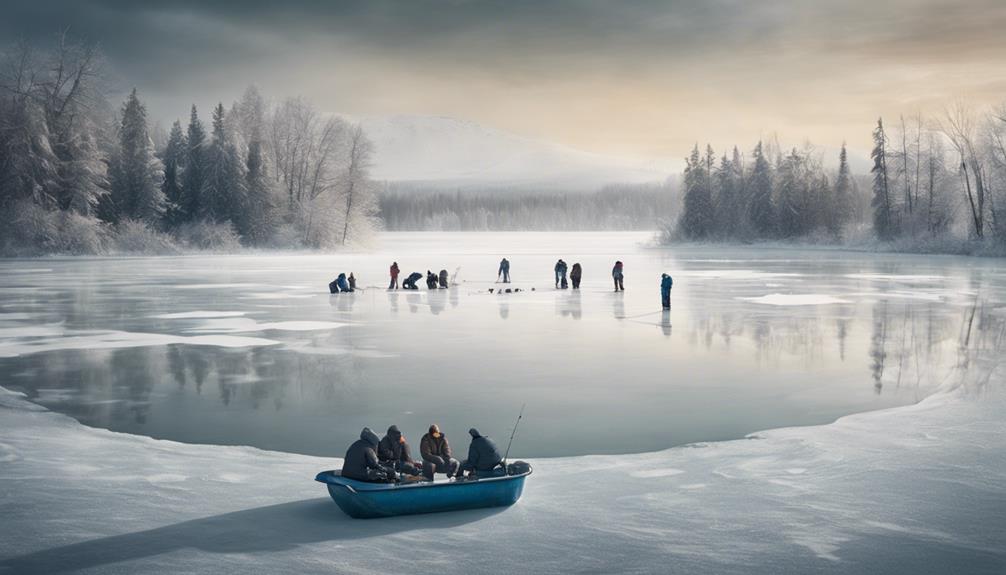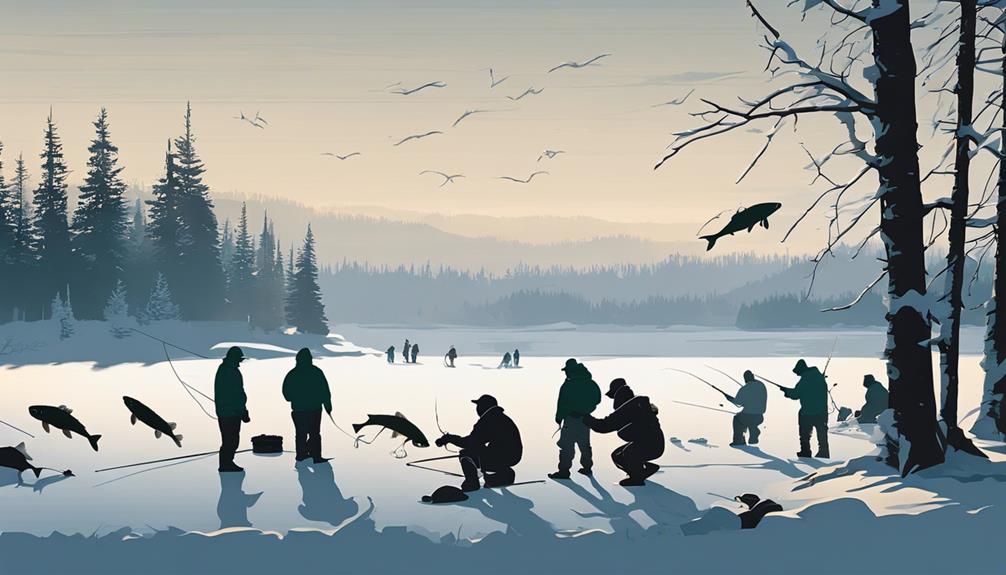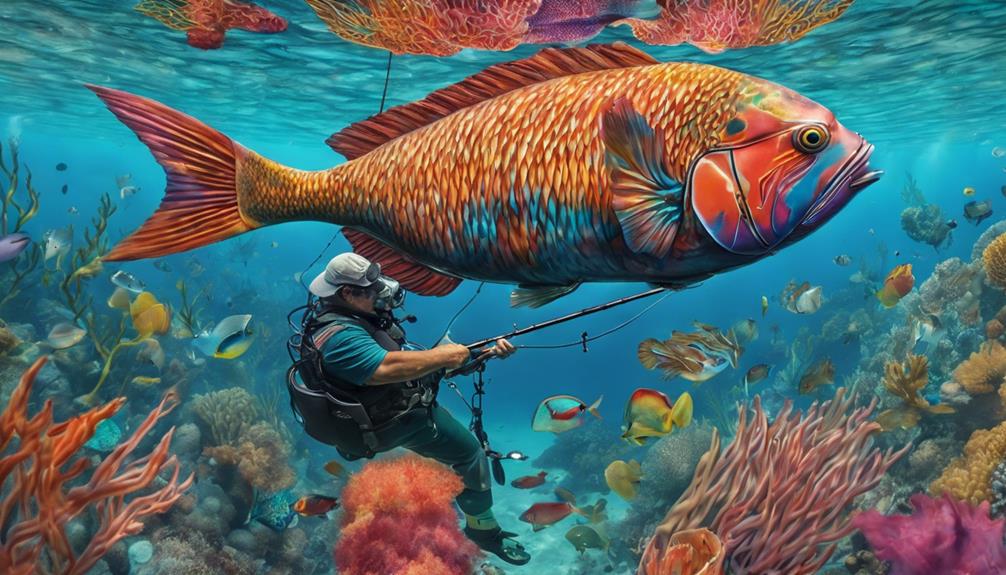When it comes to ice angling in winter, the variety of species you can target is astonishing. From the elusive walleye to the feisty pike, each species presents its own set of challenges and rewards.
Understanding their behaviors and preferences in the icy depths can greatly enhance your chances of success on the frozen waters.
So, let's explore the unique strategies and techniques needed to reel in these winter species and make the most of your ice angling adventures.
Walleye Ice Angling Tips
To maximize your success in catching walleye while ice angling, prioritize patience and precision in your movements. When it comes to walleye jigging techniques, consider using a subtle up and down motion to attract these elusive fish. They're known for their finicky nature, so a gentle approach can often yield better results. Additionally, having the right ice shelter can make a significant difference in your comfort and ability to stay focused on the task at hand. Choose a shelter that provides adequate insulation and protection from the elements to enhance your overall ice fishing experience.
When selecting the best bait for walleye, keep in mind that these fish are particularly fond of live bait such as minnows or shiners. Using lively bait can entice walleye more effectively than artificial lures. As for choosing the right rod, opt for a medium-action rod with a sensitive tip to detect subtle bites. This type of rod allows you to feel the movements of the fish better, increasing your chances of a successful hookset.
Perch Ice Fishing Techniques
When targeting perch through ice fishing, focus on using light tackle and adopting a subtle jigging technique to attract these smaller but plentiful fish. Perch are often found in schools near underwater structures such as weed beds, drop-offs, or rocky areas. To increase your chances of success, drill multiple holes and move around until you locate a school of perch.
For presentation, small jigs or spoons tipped with bait like minnows or waxworms work well. Keep your presentation lively by gently jigging the bait to mimic natural movements. Perch have keen eyesight, so using light lines in the 2-4 lb test range is crucial to avoid spooking them. Fluorocarbon leaders can also increase your chances of getting more bites.
Before starting your perch ice fishing adventure, ensure your equipment is in top condition. Check your ice auger to guarantee it can drill through thick ice efficiently. It's also essential to have a quality ice fishing rod, small tackle box with a variety of jigs and bait, an ice scoop to keep the hole clear, and a comfortable ice fishing chair to sit on while waiting for the perch to bite.
Trout Strategies for Ice Angling
For successful ice angling targeting trout, focus on adapting your bait and jigging technique to entice these elusive fish. When it comes to rainbow trout tactics, consider using small jigs tipped with maggots or waxworms. These colorful fish are attracted to movement, so try jigging your bait gently to mimic natural prey.
Brook trout secrets involve using light line and subtle presentations. These sensitive fish spook easily, so opt for finesse when jigging and avoid sudden movements.
When targeting brown trout, employ slightly larger jigs paired with minnows or artificial lures. Brown trout techniques often involve varying your jigging motion to find what entices the fish on that particular day. These trout are known to be more aggressive, so don't be afraid to experiment with faster jigging speeds.
For lake trout strategies, go big with your bait. Large spoons or jigs tipped with smelt or other sizable baitfish can attract these apex predators. Lake trout are often found in deeper waters, so make sure your gear is equipped to handle the depths. Vary your jigging depth to locate where the lake trout are feeding.
Pike Fishing in Winter
Winter brings a surge of excitement for anglers targeting pike in frozen waters. When it comes to pike fishing in winter, knowing the right winter pike hotspots can significantly increase your chances of success. Look for areas with vegetation or structures that provide cover and attract baitfish, as pike often lurk in these spots waiting to ambush their prey. To effectively fish these areas, having the right ice angling gear is crucial. Make sure to use a sturdy ice auger to drill through the ice, a reliable ice fishing rod and reel, and appropriate cold-weather clothing to stay comfortable on the ice.
Choosing the best bait for pike is essential for a successful ice angling trip. Large live baits such as suckers or shiners work well to entice big pike lurking beneath the ice. Additionally, using tip-ups with live bait can be an effective way to cover more water and increase your chances of hooking into a trophy pike. When it comes to ice angling techniques for pike, try jigging with large spoons or swimbaits to mimic the movements of baitfish. Vary your jigging cadence and experiment with different depths until you find where the pike are actively feeding. By focusing on these key aspects of winter pike fishing, you can enhance your chances of landing a big catch during the icy months.
Panfish Ice Angling Tactics
Exploring effective tactics for targeting panfish through ice angling can significantly broaden your winter fishing skills. When it comes to panfish like crappie, mastering jigging techniques is crucial. Try using small jigs tipped with minnows or soft plastics to mimic their prey. Vary your jigging motion to entice more bites.
For bluegill, hole hopping is a popular strategy. Since bluegill are often found in schools, drilling multiple holes and moving between them can help you locate active fish.
Depth finding is key when targeting sunfish. Use a fish finder to locate schools at different depths. Sunfish tend to hang out near the lake bottom, so adjusting your bait's depth accordingly is essential.
As for perch, selecting the right lure is vital. Perch are known for being finicky, so having a variety of small jigs and spoons in your tackle box can increase your chances of success. Experiment with different colors and sizes to see what the perch are responding to on that particular day.
Bass Behavior in Ice Fishing
Understanding bass behavior during ice fishing requires keen observation and strategic adaptation to their movements beneath the frozen surface. Bass, known for their elusive nature, exhibit unique feeding patterns and seek shelter in the icy waters. Here are some key insights to help you enhance your bass ice fishing experience:
- Bass Feeding Habits: Bass are opportunistic feeders, making them more active during specific times of the day. Understanding their feeding habits can help you choose the right bait and fishing technique to lure them in.
- Ice Shelter Selection: Bass tend to seek shelter in vegetation, rock formations, or other structures under the ice. Identifying these shelters can increase your chances of locating bass and successfully catching them.
- Temperature Sensitivity: Bass are sensitive to temperature changes, affecting their activity levels. Monitoring water temperatures can give you valuable clues about where bass might be located and how they're behaving.
- Depth Adjustment: Bass often adjust their depth in response to various factors like light penetration and food availability. Experimenting with different depths can help you pinpoint the optimal fishing zone.
- Patience and Persistence: Bass fishing in winter requires patience and persistence. Being observant, adapting to changing conditions, and staying focused are key elements to outsmarting bass beneath the ice.
Salmon Ice Angling Insights

Salmon ice angling presents a new set of challenges and strategies compared to bass fishing in winter months. When targeting salmon species like steelhead or Arctic char through the ice, understanding their behavior and preferences is crucial. Steelhead, known for their strength and acrobatics, tend to be more active during low light conditions. To increase your chances of success, try fishing early in the morning or late in the evening when steelhead are more likely to be actively feeding. Using brightly colored jigs or spoons can also attract their attention.
Arctic char, on the other hand, are known for their cautious nature and can be more challenging to entice. When targeting Arctic char, consider downsizing your bait and using subtle presentations. Light line and small jigs tipped with bait like maggots or small minnows can be effective in tempting these finicky fish. Additionally, setting up near underwater structures where char are known to hide can improve your chances of a successful catch.
Catfish Winter Fishing Methods
When targeting catfish during the winter months, adapting your fishing techniques to their unique behavior is essential for a successful angling experience. Catfish in cold waters exhibit distinct habits, and understanding these can significantly improve your chances of a successful winter fishing trip.
Catfish Winter Fishing Methods
- Catfish Baiting Techniques: Experiment with various baits such as cut bait, worms, or even stink baits to see what entices catfish during the winter months.
- Winter Catfish Location: Look for deeper holes or areas with slow-moving water where catfish tend to gather to conserve energy in the colder temperatures.
- Ice Fishing for Catfish: In regions where lakes freeze over, try ice fishing for catfish using specialized equipment like tip-ups or jigging rods for a unique winter angling experience.
- Cold Water Catfish Habits: Catfish are less active in cold water, so be patient and give your bait enough time to attract their attention before moving to a new spot.
- Adapt Your Techniques: Adjust your fishing style by using heavier tackle and fishing closer to the bottom where catfish are more likely to be during the winter months.
Frequently Asked Questions
Can Ice Fishing Be Done Safely on All Types of Bodies of Water, or Are There Specific Conditions That Need to Be Met?
You can safely ice fish on various bodies of water, but it's crucial to ensure the ice thickness meets safety standards.
Different bodies of water require different thickness levels for safe ice fishing. Proper gear, like ice picks and a life jacket, is essential for added safety.
Always check ice thickness, avoid areas with flowing water, and fish with a buddy. Following these safety tips and best practices will make your ice fishing experience enjoyable and secure.
Are There Any Particular Safety Precautions That Anglers Should Take When Ice Fishing in the Winter?
When ice fishing in winter, remember to always prioritize safety. Check ice thickness regularly and use proper gear for maximum safety. Keep an eye on weather conditions and be prepared for emergencies. Stay alert and aware of your surroundings at all times.
How Does the Behavior of Fish Change in the Winter Compared to Other Seasons?
During winter, fish behavior shifts due to the colder temperatures. They tend to move slower and stay in deeper waters to conserve energy.
Winter patterns can include feeding less frequently and being more selective with bait. Understanding these changes can help you adapt your ice angling techniques to attract bites successfully.
What Are Some Common Mistakes That Beginner Ice Anglers Make, and How Can They Be Avoided?
When you're just starting out with ice angling, it's common to make some mistakes. One of the most frequent errors isn't checking the ice thickness regularly. Remember to always test it before venturing out.
Another slip-up isn't dressing warmly enough. Avoid this by layering up and staying cozy.
Lastly, beginners often forget to bring the right gear. Double-check your equipment before hitting the ice for a successful angling experience.
Are There Any Regulations or Restrictions That Anglers Need to Be Aware of When Ice Fishing in the Winter?
When ice fishing during winter, it's crucial to know the ice fishing regulations and winter angling restrictions in your area. These rules help protect the environment and ensure everyone's safety on the ice.
Be sure to check the specific regulations for the body of water you're fishing in, such as limits on the number of lines you can use, the types of bait allowed, and any size restrictions on the fish you can keep.
Conclusion
Now that you have learned about the different winter species that thrive in ice angling, you can head out to the frozen waters with confidence.
Remember to use the tips and strategies provided for walleye, perch, trout, pike, panfish, bass, salmon, and catfish.
With the right techniques and knowledge, you'll be sure to have a successful and enjoyable ice fishing experience.
Stay warm and happy fishing!



